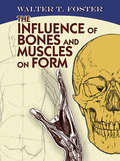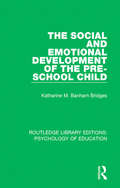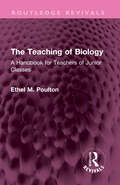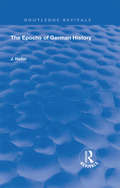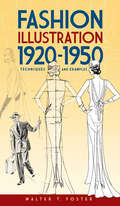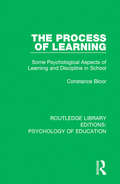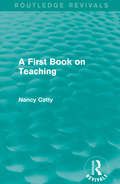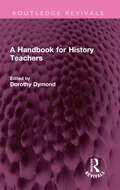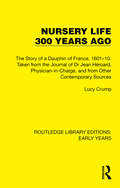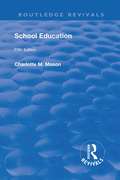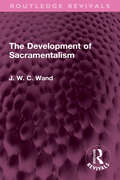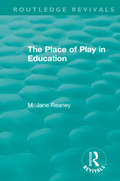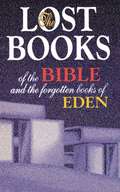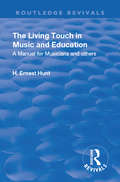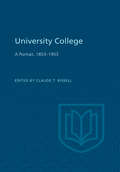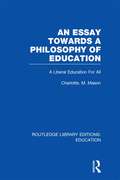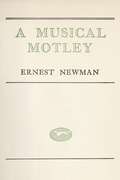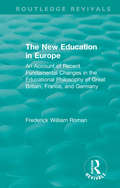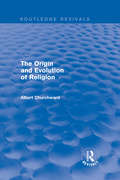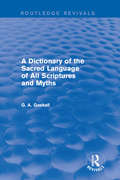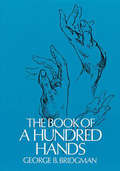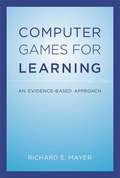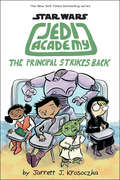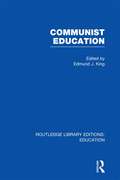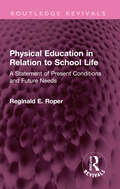- Table View
- List View
The Influence of Bones and Muscles on Form (Dover Anatomy for Artists)
by Walter T. FosterA thorough acquaintance with human anatomy is a valuable asset for artists wishing to master figure drawing. This single-volume treatment combines separate treatises on drawing muscles and bones. Each page features multiple illustrations, accompanied by extensive descriptions offering lucid explanations of bone and muscle placement, function, and artistic re-creation.
The Social and Emotional Development of the Pre-School Child (Routledge Library Editions: Psychology of Education)
by Katharine M. Banham BridgesOriginally published in 1931, the study reported in this book was undertaken as part of the research programme of the Canadian National Committee for Mental Hygiene. It represents a systematic inquiry into the social and emotional behaviour of pre-school children as observed from day to day in a nursery school. The study extended over a period of three years, and it concerned children between the ages of two and five years who were in attendance at the McGill University Nursery School and child laboratory. It can now be read and enjoyed in its historical context.
The Teaching of Biology: A Handbook for Teachers of Junior Classes (Routledge Revivals)
by Ethel M. PoultonFirst published in 1931, the original blurb reads: "A practical handbook for those who are engaged in teaching elementary biology (Nature Study) to children of 10-13 years. Part I is devoted to general methods of teaching the subject. Part II consists of subject matter suitable for lessons, together with suggestions as to practical work and classroom procedure." It was hoped that this work would help the move away from the tradition, still prevalent at the time, where observation of minute details and absence of associated physiological work left the children with little interest in the subject. This book would contribute to a type of teaching where more regard was paid to the ‘livingness’ of the organism, resulting in the deepening of the pupil’s enjoyment of the beauty of animate nature. Today it can be read in its historical context.
The Epochs of German History (Routledge Revivals #18)
by J. HallerOriginally published in 1930. This book is not intended to be a discussion on German history, but to talk about its epochs, a period in which some fresh beginning is made, some fresh determining element enters, some event occurs to give a new direction to the course of history. The book is concerned with the critical moments of German history, the turning points in its course. Those are what we want to consider, wnd also to select as points of vantage from which we may survey the development of the German nation, viewing the panorama section by section.
Fashion Illustration 1920-1950: Techniques and Examples (Dover Art Instruction)
by Walter T. FosterComprehensive and user-friendly, this volume combines four vintage instructional manuals by Walter T. Foster, the world-famous art teacher and publisher. In addition to explaining the principles of figure drawing, it provides a handy retrospective of fashions for men, women, and children from the first half of the twentieth century. This authentic guide to vintage styles features a splendid range of apparel, from ladies' lingerie and evening gowns to men's business suits and children's play clothes. Artists at every level of experience will benefit from tips on portraying figures in motion and at rest, along with advice on accurate renditions of clothing folds and patterns. Step-by-step drawings with helpful comments explain a variety of techniques, including pencil, pen, wash, and opaque.
The Process of Learning: Some Psychological Aspects of Learning and Discipline in School (Routledge Library Editions: Psychology of Education)
by Constance BloorOriginally published in 1930, this book was designed to meet the needs of students in Training Colleges. It is the outcome of first-hand experience of the difficulties encountered by students in the subject of educational theory and its application to the problems of the classroom at the time. It was the hope of the writer that this book may help the student to find a profitable connection between the theory of the lecture room and the problems of the school classroom.
A First Book on Teaching (Routledge Revivals)
by Nancy CattyFirst published in 1929, this book is a beginner's guide to the practice of teaching. The preparation and giving of lessons, the function of class teaching, sectionizing and individual work, the art of happy relations between class and teacher, the foundations of school tone, and the tests of a good curriculum are discussed and illustrated from school and training college experience. Use is made of the reader's memories of school-days, and the exercises, an integral part of the book, provide a critical reading. A study of the text as a basis for discussion makes an excellent preparation for teaching.
A Handbook for History Teachers (Routledge Revivals)
by Dorothy DymondFirst Published in 1929 A Handbook for History Teachers is an attempt on the part of a number of teachers (many of them members of the S. E. London branch of the Historical Association) to offer some practical help in the choice of historical material for children. It discusses themes like schemes of work in elementary junior and senior schools, textbooks for pupils under fifteen, class library books for pupils under fifteen, book lists for teachers, and sources for the preparation of history stories by the teacher. This is an essential read for history teachers and education.
Nursery Life 300 Years Ago: The Story of a Dauphin of France, 1601–10. Taken from the Journal of Dr Jean Héroard, Physician-in-Charge, and from Other Contemporary Sources (Routledge Library Editions: Early Years)
by Lucy CrumpOriginally published in 1929, Nursery Life 300 Years Ago is about the childhood of a seventeenth-century Dauphin of France, taken from the journal of Dr. Jean Heìroard, physician-in-charge and other contemporary sources, which is used as a medium for describing the education, toys and other social aspects of childhood at that time. A fascinating glimpse into the historic study of children.
Revival: Volume III (Routledge Revivals)
by Mason M. CharlotteSchool Education, the third volume of Charlotte Mason's Homeschooling Series, consists of thoughts about the teaching and curriculum of children aged 9-12, either at school or at home. She suggests that parents should practice what she calls "masterly inactivity"-not neglectful or permissive parenting, but simply allowing children to work things out for themselves, do things for themselves, learn from their own mistakes, and to have time for free play, and space for spontaneity. Charlotte Mason uses "living books" instead of dry textbooks; in this book, she discusses what kinds of books to look for in each subject, and how to use them to teach children to love knowledge and become real readers and lifelong learners. Charlotte Mason was a late nineteenth-century British educator whose ideas were far ahead of her time. She believed that children are born persons worthy of respect, rather than blank slates, and that it was better to feed their growing minds with living literature and vital ideas and knowledge, rather than dry facts and knowledge filtered and pre-digested by the teacher. Her method of education, still used by some private schools and many homeschooling families, is gentle and flexible, especially with younger children, and includes first-hand exposure to great and noble ideas through books in each school subject, conveying wonder and arousing curiosity, and through reflection upon great art, music, and poetry; nature observation as the primary means of early science teaching; use of manipulatives and real-life application to understand mathematical concepts and learning to reason, rather than rote memorization and working endless sums; and an emphasis on character and on cultivating and maintaining good personal habits. Schooling is teacher-directed, not child-led, but school time should be short enough to allow students free time to play and to pursue their own worthy interests such as handicrafts.
The Development of Sacramentalism (Routledge Revivals)
by J. W. WandFirst published in 1928, The Development of Sacramentalism traces the history of the fundamental presuppositions upon which the doctrine of sacraments is built from primitive religions, through the Old Testament and the Mystery Cults. This book will be of interest to students of history and religion.
The Place of Play in Education (Routledge Revivals)
by M. Jane ReaneyOriginally published in 1927, this was a book written specially for teachers and parents, based upon the writer’s practical experience and research. It deals with the fundamental importance of play in the child’s development and as a basis for all education. A set of 74 games, arranged by Miss Amy Whateley, is appended, in four groups according to the four play periods of childhood. Today it can be read and enjoyed in its historical context.
Lost Books of the Bible and the Forgotten Books of Eden
by Thomas NelsonThough apocryphal in nature, these books--suppressed by the Church Fathers--are fascinating and beautifully written. Here you can read for yourself many of the manuscripts which were excluded form the Cannon of Scripture, and discover new appreciation for those which were chosen.Now in tradepaper and ebook formats!
Revival: A Manual for Musicians and Others (Routledge Revivals)
by H. Ernest HuntThese chapters contain the subject matter of a year’s course of thirty lectures which have now, for several years past, been given in connection with the Training School for Music Teachers, London, W. I.
University College: A Portrait, 1853-1953
by Claude BissellFor a century University College has had a profound and continuous influence on the cultural development of Canada. The authors of this volume show us University College as a political and educational institution; as a physical structure that has aroused admiration and scholarly curiosity; as the home of a long line of great teachers and scholars, and of a student body diverse in its origins and spirited in its attitudes; and finally, as the embodiment of an educational idea that transcends curricula and prescriptions.
An Essay Towards A Philosophy of Education: A Liberal Education for All (Routledge Library Editions: Education)
by Charlotte M MasonThis was the last and most important and comprehensive work of Charlotte Mason, (founder of the Parents’ National Educational Union). For more than half a century the practical results of her original thought on education could be seen in all parts of the world in the Charlotte Mason Method and the Parents’ Union Schools.
A Musical Motley
by Ernest NewmanThis is a reproduction of a book published before 1923. This book may have occasional imperfections such as missing or blurred pages, poor pictures, errant marks, etc. that were either part of the original artifact, or were introduced by the scanning process. We believe this work is culturally important, and despite the imperfections, have elected to bring it back into print as part of our continuing commitment to the preservation of printed works worldwide. We appreciate your understanding of the imperfections in the preservation process, and hope you enjoy this valuable book.
The New Education in Europe: An Account of Recent Fundamental Changes in the Educational Philosophy of Great Britain, France, and Germany (Routledge Revivals)
by Frederick William RomanOriginally published in 1924, as outlined in the preface, this book is "based on the belief that the only substantial hope of rescue in the present world-crisis and the saving of even civilization itself depend upon the degree to which the creative thought that the coming generations may bring is applied to a continued and purposeful reconstruction of the modes of living. The world is in need, as never before, of stronger and more clearly-conceived ideals of conscious effort in the service of humanity. The salvation of society must be mined out of its own depths. Much of this work must be done by those now at school, and therefore we are at once led to inquire to what extent the present systems of education provide for conditions that are provocative of free and spontaneous thought." "In each of the several countries with which the present study is concerned there is a considerable body of men and women who have undertaken a serious and thoughtful campaign of education. The pages that follow attempt to give a summary account of the origin and the likelihood of success of these several undertakings."
The Origin and Evolution of Religion (Routledge Revivals)
by Albert ChurchwardChurchward’s The Origin and Evolution of Religion, first published in 1924, explores the history and development of different religions worldwide, from the religious cults of magic and fetishism to contemporary religions such as Christianity and Islam. This text is ideal for students of theology.
A Dictionary of the Sacred Language of All Scriptures and Myths (Routledge Revivals)
by G GaskellG. A. Gaskell’s Dictionary of the Sacred Language of All Scriptures and Myths, first published in 1923, examines several different aspects of religion, including examples from Ancient Egyptian religion and mythology to modern-day Christianity, providing explanations of gods, events, and symbols in alphabetical order. This is a perfect reference book for students of theology or the history of religion.
The Book of a Hundred Hands (Dover Anatomy for Artists)
by George B. BridgmanMr. Bridgman states unequivocally in his introduction that before preparing this book he had "not discovered a single volume devoted exclusively to the depicting of the hand." Apparently Mr. Bridgman has appreciated what few others have felt -- the human hand's great capacity for expression and the care that the artist must take to realize it. The hand changes with the age of the person, is shaped differently according to sex, reflects the type of work to which it is put, the physical health, and even the emotions of the person. To represent these distinguishing features, to capture the expressiveness of a particular pair of hands, the artist must understand the construction, anatomy, formation, and function of the hand.There is probably no better instructor to turn to for this understanding than Mr. Bridgman, a well-respected artist who for nearly 50 years lectured and taught at the Art Students League of New York. In this volume, a full text is accompanied by many illustrations depicting virtually every aspect and posture of the human hand. He first considers the back view of the hand, the wrist bones, the tendons, the muscles, the hand bones, the arch, and the veins; and then those of the palm. Throughout he pictures the musculature at work beneath the surface of the skin. He continues by showing how the muscles operate on the thumb side and on the little finger side when each is the center of force; how the thumb and fingers are constructed, their freedom of movement, joints, and complete anatomy as well as views of them straight, bent, and flexed; how the knuckles are formed, what shapes the fist can take and how flexible it can be; and he concludes with illustrations of the total movement, either turning or rotary, of the hand in its various positions.The 100 illustrations the author has selected perfectly define the regions of the hand so that any artist, beginning or experienced, will increase his mastery of it. Better rendering of the human hand is sure to add new expressiveness to your human figures along with new forcefulness and new interest.
Computer Games for Learning
by Richard E. MayerMany strong claims are made for the educational value of computer games, but there is a need for systematic examination of the research evidence that might support such claims. This book fills that need by providing, a comprehensive and up-to-date investigation of what research shows about learning with computer games. Computer Games for Learning describes three genres of game research: the value-added approach, which compares the learning outcomes of students who learn with a base version of a game to those of students who learn with the base version plus an additional feature; the cognitive consequences approach, which compares learning outcomes of students who play an off-the-shelf computer game for extended periods to those of students who do not; and the media comparative approach, which compares the learning outcomes of students who learn material by playing a game to those of students who learn the same material using conventional media. After introductory chapters that describe the rationale and goals of learning game research as well as the relevance of cognitive science to learning with games, the book offers examples of research in all three genres conducted by the author and his colleagues at the University of California, Santa Barbara; meta-analyses of published research; and suggestions for future research in the field. The book is essential reading for researchers and students of educational games, instructional designers, learning-game developers, and anyone who wants to know what the research has to say about the educational effectiveness of computer games.
The Principal Strikes Back (Star Wars: Jedi Academy #6)
by Jarrett J. KrosoczkaAs told through a mix of comics, doodles, and journal entries, it's Victor Starspeeder's third year at Jedi Academy! It's also his first year EVER without his sister, Christina. Plus, things at Jedi Academy are... weird. After last year's security breach, Principal Marr has been demoted and replaced with Commander ZC-04, a big, scary droid. There's a curfew, new regulations, and everyone is on edge. But when Victor and his friends dig a little deeper into the changes at the school, they find that there's a lot more to this story than the droids want to admit! It's an all-new, out-of-this-world Jedi Academy adventure as The Principal Strikes Back!
Communist Education (Routledge Library Editions: Education)
by Len Barton Martin LawnDevelopments and trends in Communist education are traced in this authoritative survey by specialists. Eight chapters deal with particular aspects: ideology, psychology, the selective process, the roles of teachers and parents, polytechnical education, the universities and professional institutes. Three chapters survey the former East Germany, Poland and China as special case-studies. A concluding chapter examines common ground between Communist and other systems.
Physical Education in Relation to School Life: A Statement of Present Conditions and Future Needs (Routledge Revivals)
by Reginald E. RoperFirst published in 1917, Physical Education in Relation to School Life views the problems of growth and health in relation to education. The main outlines of a satisfactory physical education and its importance are indicated. The author has compared his aims and objectives, and appreciated the practical value of some of the better-known methods of dealing with the problems, and has suggested the direction in which future improvements may most usefully be sought. This book will be of interest to students of physical education, pedagogy and history.
